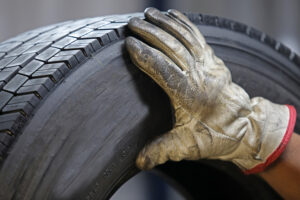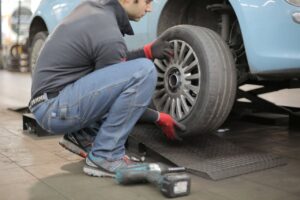What is a slow puncture and how can I identify one?
You could, without knowing, be driving around with a slow puncture for weeks, even months. They are common occurrences but can be more difficult to detect than your usual puncture, which you would notice straight away. In this article, you’ll find out what a slow puncture is, the warning signs and most importantly, slow puncture repair tips, should you ever need them.
What is a slow puncture?
A slow puncture is an easily missable tiny hole in the tyre that causes air to escape slowly but very gradually. Unlike larger punctures that you are likely to notice immediately due to the tyre deflating a lot quicker, it can take days, to weeks and even months to notice any deflation of your tyre, or enough to make it become obvious to yourself that a puncture has in fact occurred. The only slight indication you may see when looking at your tyres is a slight continuous hissing noise where the air is escaping. The causes of a slow puncture are usually driving over something small such as a piece of glass or a nail, or debris on the road’s surface. A less common cause of a slow puncture could be an issue with the tyre valve. If the cap is not sealed tightly enough, or the valve dust cap is missing, the tyre can very easily start to lose air.
The warning signs of a slow puncture
Whilst slow punctures are hard to spot and you may not notice them at first, there are a few tell tale signs you can look out for if you think you may have a slow puncture in one or more of your tyres.
- Changes to vehicle handling. If your suspension feels harder than usual or any changes have happened with the responsiveness of your car, you will need to take it to the repair shop in order for the puncture(s) to be fixed.
- Continual loss of tyre pressure. A lot of cars have Tyre pressure monitoring systems (TPMS) that detect any loss of pressure, but if you are continuously having to put air in your tyres, this will be an indication that your tyre may have a slow puncture.
- Vibration from a steering wheel. Unbalanced tyres with different pressures will cause vibrations from the steering wheel. This is most noticeable when driving at high speeds.
How to repair a slow puncture
A slow puncture repair is quick and easy in most cases, but this will depend on what exactly is causing the problem. For example, if a nail or a sharp piece of debris is embedded in the tyre, a specialist will easily be able to fit a rubber plug to repair the slow puncture. However, if your car is fitted with high-performance tyres, it may be a more difficult task. This is because high-performance tyres are developed to withstand higher stresses than ordinary tyres so they cannot have any vulnerabilities. If your high-performance tyres have sidewall or rim damage, they will need replacing and cannot be repaired. A temporary, easy fix for a short period of time until you can get your car to a repair centre would be to use a DIY slow puncture repair kit. These however are not long-term fixes, and it is always advised that you get professional assistance as soon as possible. Please note, this is not possible for any tyres that have Run-flat technology, so these will need to be taken to a professional as soon as the puncture has been discovered.




